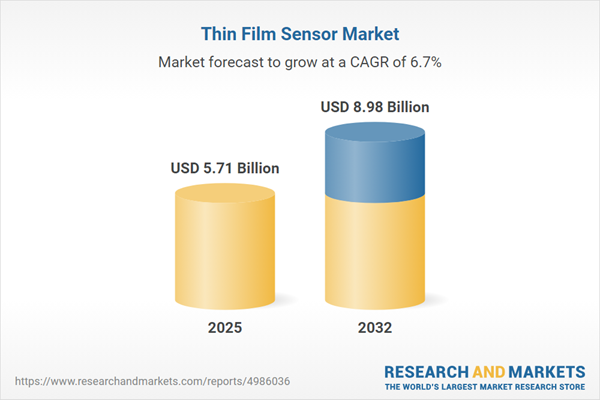Speak directly to the analyst to clarify any post sales queries you may have.
The thin film sensor market is advancing rapidly, enabling a new standard for precision measurement and integration in digital ecosystems. Senior leaders seeking reliable sensing technologies will find this analysis delivers focused, actionable intelligence on core market movements, resilience strategies, and transformative opportunities in thin film sensor adoption.
Market Snapshot: Thin Film Sensor Market Trends & Dynamics
The Thin Film Sensor Market grew from USD 5.35 billion in 2024 to USD 5.71 billion in 2025 and is forecasted to reach USD 8.98 billion by 2032 at a CAGR of 6.69%. This significant growth is propelled by widespread adoption in critical fields, driven by precision demands, tighter regulatory standards, and the ongoing expansion of smart infrastructures worldwide. End users are prioritizing reliable data capture and integration capabilities, with market momentum reinforced by digital transformation and industrial automation across major regions.
Scope & Segmentation of the Thin Film Sensor Market
The report offers in-depth coverage and strategic segmentation across the thin film sensor value chain. Categories analyzed encompass product types, technologies, substrate configurations, end use industries, and key regional markets.
- Product Types: Gas sensors (Catalytic Bead, Electrochemical, Metal Oxide Semiconductor, Photoionization Detector), Humidity sensors (Capacitive, Resistive), Pressure sensors (Capacitive, Optical, Piezoelectric, Piezoresistive), Temperature sensors (Resistive Temperature Detector, Thermistor)
- Sensor Technologies: Capacitive, Optical, Piezoelectric, Resistive
- Substrate Types: Flexible Substrate, Rigid Substrate
- End Use Industries: Aerospace & Defense, Automotive, Consumer Electronics, Energy & Utilities, Healthcare, Industrial
- Regions: Americas (United States, Canada, Mexico, Brazil, Argentina, Chile, Colombia, Peru), Europe (United Kingdom, Germany, France, Russia, Italy, Spain, Netherlands, Sweden, Poland, Switzerland), Middle East (United Arab Emirates, Saudi Arabia, Qatar, Turkey, Israel), Africa (South Africa, Nigeria, Egypt, Kenya), Asia-Pacific (China, India, Japan, Australia, South Korea, Indonesia, Thailand, Malaysia, Singapore, Taiwan)
- Key Market Players: Analog Devices, Infineon Technologies AG, Robert Bosch GmbH, STMicroelectronics, Texas Instruments, Siemens AG, Sensirion AG, NXP Semiconductors, Murata Manufacturing, Honeywell International
Key Takeaways for Senior Decision-Makers
- Thin film sensor technology enables multi-parameter measurement, adaptable form factors, and integration across diverse platforms.
- Material and microfabrication innovations have broadened applications, with improved film uniformity and device reliability supporting deployment in demanding sectors.
- Advanced analytics and machine learning integration enhance sensor functionality, moving thin film sensors from basic detectors to intelligent platforms.
- Strategic manufacturing and sourcing adaptations are crucial, particularly as regulatory and geopolitical challenges reshape supply chains.
- Flexible substrate use supports innovation in wearables and curved components, while rigid bases maintain high precision in aerospace and industrial instrumentation.
- Leading companies invest in R&D partnerships, patent expansion, and digital ecosystems, driving market differentiation through holistic sensing solutions.
Tariff Impact: Evolving Cost Structures & Supply Chain Risk
Recent United States tariff measures have affected the full spectrum of thin film sensor supply chains. Increased duties on core materials have driven companies to reevaluate supplier partnerships, localize sourcing, and renegotiate contracts. This evolution is shaping procurement and manufacturing strategies, resulting in a more diversified vendor base and increased process automation to maintain margin stability and operational resilience.
Research Methodology & Data Sources
This report leverages both primary and secondary research to underpin its market insights. Analysts conducted structured interviews with executives and engineers across key industries, supplemented by detailed reviews of technical literature, regulatory documentation, and patent filings. Data validation and case study comparisons assure accuracy and actionable relevance.
Why This Report Matters
- Empowers business leaders to optimize product development and supply chain strategies by anticipating technological and regulatory shifts.
- Supports targeted investment with granular segmentation and actionable competitor intelligence across leading regions and companies.
- Enables executive teams to align innovation roadmaps and risk management to evolving end user demands and market disruptors.
Conclusion
Thin film sensors are redefining measurement and integration standards across industries. Strategic adaptation and ongoing investment position market participants to capture opportunity in a dynamic, data-driven global landscape.
Additional Product Information:
- Purchase of this report includes 1 year online access with quarterly updates.
- This report can be updated on request. Please contact our Customer Experience team using the Ask a Question widget on our website.
Table of Contents
3. Executive Summary
4. Market Overview
7. Cumulative Impact of Artificial Intelligence 2025
Companies Mentioned
The companies profiled in this Thin Film Sensor market report include:- Analog Devices, Inc.
- Infineon Technologies AG
- Robert Bosch GmbH
- STMicroelectronics
- Texas Instruments Incorporated
- Siemens AG
- Sensirion AG
- NXP Semiconductors N.V.
- Murata Manufacturing Co., Ltd.
- Honeywell International Inc.
Table Information
| Report Attribute | Details |
|---|---|
| No. of Pages | 196 |
| Published | November 2025 |
| Forecast Period | 2025 - 2032 |
| Estimated Market Value ( USD | $ 5.71 Billion |
| Forecasted Market Value ( USD | $ 8.98 Billion |
| Compound Annual Growth Rate | 6.6% |
| Regions Covered | Global |
| No. of Companies Mentioned | 11 |









